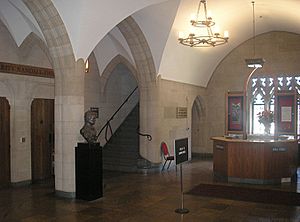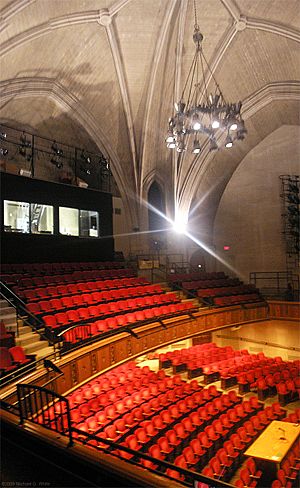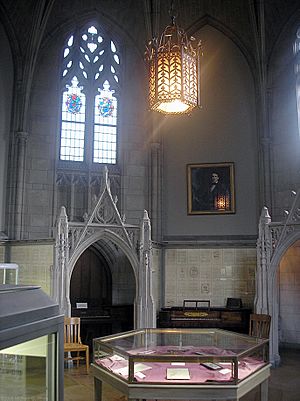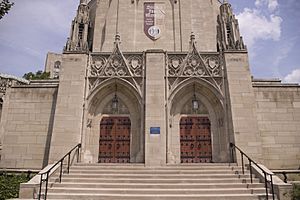Stephen Foster Memorial facts for kids
|
Stephen Collins Foster Memorial
|
|
|
U.S. Historic district
Contributing property |
|
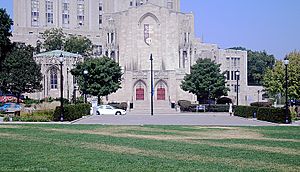
Stephen Foster Memorial at the University of Pittsburgh
|
|
| Location | Pittsburgh, Pennsylvania, USA |
|---|---|
| Built | 1935–1937 |
| Architect | Charles Klauder |
| Architectural style | Gothic Revival |
| Part of | Schenley Farms Historic District (ID83002213) |
Quick facts for kids Significant dates |
|
| Added to NRHP | July 22, 1983 |
The Stephen Collins Foster Memorial is a special building at the University of Pittsburgh in Pittsburgh, Pennsylvania, USA. It's a place for performances and a museum. It also keeps the Stephen Foster Archives. This memorial celebrates the life and music of Stephen Foster, a famous American songwriter.
The memorial is an important part of the Schenley Farms Historic District. It is also recognized as a Pittsburgh History and Landmarks Foundation Historical Landmark. Plus, a Pennsylvania Historical and Museum Commission Historical Marker shows its importance. You can find it on Forbes Avenue in the Oakland neighborhood. It's right on the campus of the University of Pittsburgh, often called Pitt.
The main part of the building has two theaters. These are used by the university's Department of Theatre Arts. The larger one is the 478-seat Charity Randall Theatre. The smaller one is the 151-seat Henry Heymann Theatre. The left side of the building holds the Stephen Foster Memorial Museum. It also has the Center for American Music. This center contains the University of Pittsburgh's Stephen Foster Collection and archive. This collection includes original writings, over 200 copies of his songs, recordings, and other items. It even has some of Foster's musical instruments, like one of his pianos. The memorial is also home to the university's Ethelbert Nevin Collection. It also hosts the Society for American Music.
Contents
About the Memorial Building
The Stephen Foster Memorial opened in 1937. It is made of steel and covered with the same Indiana Limestone as the university's Cathedral of Learning. The architect, Charles Klauder, designed this building and the Heinz Memorial Chapel. Both were made to match his main building, the Cathedral of Learning, in a Gothic Revival style.
Construction started on March 2, 1935. Workers used 35,000 cubic feet of Indiana limestone. They also used 400 tons of steel and 2,500 cubic yards of concrete. In 2003, the memorial had a big renovation. This $3.2 million project focused on updating the theater areas.
The stone courtyard behind the memorial is special. It sits between the memorial and the Cathedral of Learning. This area is named after Josiah Kirby Lilly. He was a big supporter of the memorial. Near the Foster Shrine, there is a sundial on a stone base. It was dedicated in May 1914 to the Pittsburgh Blues. This group fought in the War of 1812. The sundial was rededicated on May 9, 1941.
The memorial building has two theaters. It also has a special shrine connected by a hallway. This shrine displays items from the university's Foster Hall Collection. The Stephen Foster Memorial is also the home for the Society for American Music. It houses the University of Pittsburgh's Center for American Music. This center has a research library, archive, and museum. It works to learn more about American music and its role in American life.
Fred Kelly Lobby
The Fred Kelly Lobby is the main entrance area for the Charity Randall Theatre. You enter through the memorial's double red doors on Forbes Avenue. The lobby has two rectangular chandeliers. These were made by Samuel Yellin, a master metalworker from Philadelphia.
The lobby also features Charles Connick stained glass windows. These windows show Shakespeare and Beethoven. They are dedicated to Josiah Kirby Lilly, who helped fund the memorial. During the 2003 renovation, new furniture was added. This included a round upholstered bench and a ticket stand. A new wrought iron chandelier was also installed. These new pieces were designed by Michael Chirigos. His work was inspired by the memorial's Gothic arches.
The bench has cabinets that show playbills for future shows. They also display items about Gene Kelly's youngest brother, Fred. Both Kelly brothers went to Pitt. Fred taught Gene and many others how to dance. The display honors Fred Kelly's achievements. He was an important choreographer and later a TV producer and director. The lobby also celebrates Pitt Theater alumni. They receive the annual Fred Kelly Award.
Charity Randall Theatre
The main theater has 478 seats. It used to be called the Foster Memorial Theatre. After a $2 million renovation in 2003, it was renamed the Charity Randall Theatre. The theater was updated to meet modern standards. Its equipment was improved, and the original look was restored.
These renovations were possible thanks to donations from the Charity Randall Foundation. This foundation was started in 1977. It honors Charity Randall, who was the sister of Pitt graduate Robert Randall. She loved the arts and passed away in a car accident. The theater's plush, deep red seats are like those first used in New York's Radio City Music Hall. They were reupholstered, and their frames were restored. The number of seats was reduced from 572 to 478. This included adding 24 new balcony seats.
Other improvements included new carpet and lighting. The lighting highlights the vaulted stone ceiling. The original Samuel Yellin chandelier was also restored. The theater now has modern sound, lighting, and production equipment. A new rigging system, actors' restroom, and stage improvements were also added.
Henry Heymann Theatre
Downstairs in the memorial is the 153-seat Henry Heymann Theatre. It has a thrust stage with seating on three sides. This theater honors Henry Heymann. He was the university's scenic designer for many years. He taught scenic design from 1968 until he retired in 1993.
The Heymann Theatre was created in 2000. It used to be a social room. This room hosted USO dances during World War II. There's also a secret tunnel from the Heymann Theatre. It goes under the Cathedral of Learning. This tunnel connects the two buildings. During the 2003 renovations, the downstairs dressing rooms were changed. They now have three "star" dressing rooms and showers. Another basement room is the home for the Tuesday Musical Club. This club first suggested building the Stephen Foster Memorial.
Foster Shrine
The left side of the building holds the Foster Shrine. You enter it from the lobby of the Charity Randall Theatre. The entrance hallway has Foster artifacts and a bust of Foster. It also has five small casement windows. These windows feature Connick stained glass. They show symbols related to Stephen Foster and his songs.
As you walk along the corridor, you'll see the entrance to the Foster Reading Room and library on your right. This room holds many items from the Foster collection. Some of the more delicate items can be seen by appointment. The corridor then opens into a 12-sided Gothic room. This room has lancet windows with Connick stained glass medallions. These medallions show different Foster songs. Inside the Shrine, you can see Foster's piano, sheet music, recordings, and other personal items. The 2003 renovation did not change the shrine. Only a fire safety system was added.
History of the Memorial
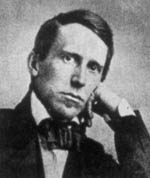
The idea for the memorial started in 1927. The Tuesday Musical Club, formed in 1889 by women musicians, teamed up with University of Pittsburgh Chancellor John Bowman. They wanted a performance hall dedicated to Stephen Foster. It would also be a place for the club's concerts. Bowman gave land next to where the Cathedral of Learning was being built for the memorial.
Not much happened until 1932. That's when Bowman learned about Josiah Kirby Lilly's Foster Hall Collection. Lilly promised to donate over 10,000 Foster items. After that, fundraising began in a big way. Almost half of the $550,000 cost came from Lilly and his son, Eli. Construction started on January 13, 1935. This was the 71st anniversary of Foster's death. The dedication ceremony happened on June 2, 1937. This was Pitt's 150th anniversary.
The Foster Hall Collection began in 1930. It was started by Josiah Kirby Lilly. He was the president of a big pharmaceutical company. The collection started as a hobby for his retirement. He loved Stephen Foster's music his whole life. It grew into one of the most important collections of American music and history. Lilly and his team, with help from Foster's relatives, gathered over 10,000 Foster items. This first collection was kept in Indianapolis. It was in a small limestone building called "Foster Hall."
Before Lilly's work, no one knew exactly how many songs Foster wrote. There was also no accurate information published about him. The staff at Foster Hall found 201 original works. Foster Hall became a key resource for John Tasker Howard's book Stephen Foster: America's Troubadour (1934). Lilly was worried about the future of his collection. So, he donated it to the University of Pittsburgh's new Stephen Foster Memorial. The collection moved to its new home in 1937. Since then, about 20,000 more items have been added. These items are about Foster, composers he influenced, and American music.
The university's Center for American Music also has the Ethelbert Nevin Collection. This collection was moved from the Theodore M. Finney Music Library in 1999. The Nevin Collection was acquired by the University of Pittsburgh between 1933 and 1956. The items were bought or donated by Mrs. Ethelbert Nevin, her family, and friends. The collection includes original writings, letters, and personal items.
Besides taking care of the collections and museum, the Center for American Music works on projects. One project is Voices Across Time. This helps teachers use historical American music in their classrooms. The center is also working on Resources of American History II. This project will make music scores, papers, and recordings available online worldwide.
See also
- Theatre in Pittsburgh
- List of music museums


